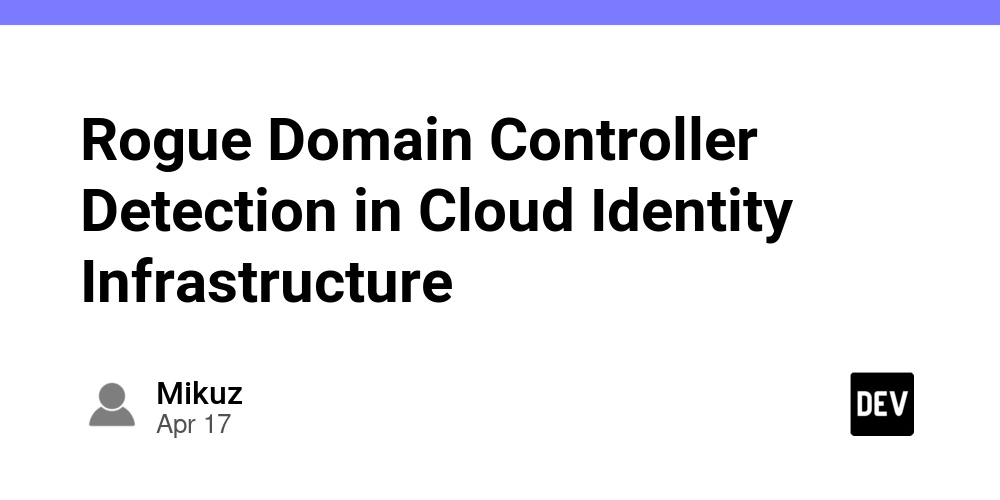Rogue Domain Controller Detection in Cloud Identity Infrastructure
Introduction: The Expanding Threat of Identity System Exploits As enterprises accelerate their migration to the cloud, attackers are adapting their methods to exploit virtual identity systems. One of the most dangerous tactics involves deploying hidden components that simulate legitimate infrastructure—such as a rogue domain controller—to quietly intercept or manipulate authentication data. Even in cloud environments without traditional on-prem domain controllers, identity services can still be compromised through virtual machines, misconfigured synchronization tools, or cloud-native directory integrations. This article focuses on identifying, isolating, and preventing these unauthorized infrastructure elements in modern cloud ecosystems. 1. Identity Infrastructure Risks in Virtualized Networks In a cloud-first environment, organizations often assume infrastructure is fully secured by default. However, identity services—whether connected to Azure AD, AWS IAM, or third-party federation tools—are vulnerable to infrastructure-level impersonation and replication attacks. Common Vulnerabilities Include: Improperly segmented cloud VMs that host directory services Excessively privileged identity synchronization tools (e.g., Azure AD Connect) Outdated or misconfigured hybrid identity bridges Weak administrative oversight over new machine identities Without robust monitoring, attackers can establish unauthorized machines that behave like trusted components in the authentication chain. 2. Techniques Attackers Use to Deploy Rogue Infrastructure Virtual Machine Deployment Cloud environments often allow users to quickly deploy virtual machines. A compromised or misused account can create a machine with the appearance of a legitimate domain service node. Exploiting Directory Synchronization Tools If synchronization agents are not locked down, attackers can hijack sync traffic or impersonate trusted services using forged certificates or stolen tokens. Abusing Administrative Privileges Cloud roles with elevated privileges are a key target. Once compromised, they can be used to authorize or replicate infrastructure changes without triggering alerts. 3. Indicators of Unauthorized Infrastructure in the Cloud Organizations should maintain visibility across both infrastructure and identity layers. Key signs of unauthorized elements in your cloud environment include: Unexpected VM provisioning events linked to identity roles Unauthorized replication behavior in hybrid sync logs Sudden changes to machine metadata (e.g., instance tags or security groups) Suspicious identity authentication patterns (e.g., service principals connecting from new IPs) Domain controller-like behavior in non-domain environments Tracking these indicators helps distinguish normal identity operations from malicious activity. 4. Detection Strategies Across Cloud Platforms Log Correlation Across Identity Services Use native logging tools like Azure Monitor, AWS CloudTrail, and Google Cloud Logging to track changes across your identity services. Combine these logs with event data from synchronization tools to spot patterns. Monitor for Role Misuse and Escalation Configure alerts for privilege escalation, including the creation of new admin accounts, changes to service principals, or deployment of machines tied to privileged identity roles. Compare Baseline Machine Profiles Use VM baselines to detect when new instances mimic the behavior or configuration of legitimate domain controllers or identity management nodes. Network Traffic and Replication Analysis Monitor internal traffic flows for replication-like behavior, including DNS registrations, Kerberos traffic, or unexpected API usage tied to authentication protocols. 5. Cloud-Native Prevention Tactics Enforce Just-In-Time Privilege Access Use tools like Azure Privileged Identity Management (PIM) to require approvals and expiration on admin access for identity services. Implement Role-Based Access Control (RBAC) Boundaries Ensure identity-related roles are split between multiple administrative tiers to reduce blast radius in case of compromise. Secure Identity Synchronization Channels Encrypt and authenticate traffic between on-prem and cloud identity bridges. Audit changes to sync configurations regularly. Harden VM and Instance Creation Policies Apply resource policies and tags to control and monitor where and how virtual machines—especially those hosting identity services—are created. 6. Response and Containment Isolation and Network Quarantine Immediately isolate suspected rogue infrastructure by disabling network access and suspending related cloud roles. Forensic Log Review Analyze logs from the moment of suspicious activity

Introduction: The Expanding Threat of Identity System Exploits
As enterprises accelerate their migration to the cloud, attackers are adapting their methods to exploit virtual identity systems. One of the most dangerous tactics involves deploying hidden components that simulate legitimate infrastructure—such as a rogue domain controller—to quietly intercept or manipulate authentication data.
Even in cloud environments without traditional on-prem domain controllers, identity services can still be compromised through virtual machines, misconfigured synchronization tools, or cloud-native directory integrations. This article focuses on identifying, isolating, and preventing these unauthorized infrastructure elements in modern cloud ecosystems.
1. Identity Infrastructure Risks in Virtualized Networks
In a cloud-first environment, organizations often assume infrastructure is fully secured by default. However, identity services—whether connected to Azure AD, AWS IAM, or third-party federation tools—are vulnerable to infrastructure-level impersonation and replication attacks.
Common Vulnerabilities Include:
- Improperly segmented cloud VMs that host directory services
- Excessively privileged identity synchronization tools (e.g., Azure AD Connect)
- Outdated or misconfigured hybrid identity bridges
- Weak administrative oversight over new machine identities
Without robust monitoring, attackers can establish unauthorized machines that behave like trusted components in the authentication chain.
2. Techniques Attackers Use to Deploy Rogue Infrastructure
Virtual Machine Deployment
Cloud environments often allow users to quickly deploy virtual machines. A compromised or misused account can create a machine with the appearance of a legitimate domain service node.
Exploiting Directory Synchronization Tools
If synchronization agents are not locked down, attackers can hijack sync traffic or impersonate trusted services using forged certificates or stolen tokens.
Abusing Administrative Privileges
Cloud roles with elevated privileges are a key target. Once compromised, they can be used to authorize or replicate infrastructure changes without triggering alerts.
3. Indicators of Unauthorized Infrastructure in the Cloud
Organizations should maintain visibility across both infrastructure and identity layers. Key signs of unauthorized elements in your cloud environment include:
- Unexpected VM provisioning events linked to identity roles
- Unauthorized replication behavior in hybrid sync logs
- Sudden changes to machine metadata (e.g., instance tags or security groups)
- Suspicious identity authentication patterns (e.g., service principals connecting from new IPs)
- Domain controller-like behavior in non-domain environments
Tracking these indicators helps distinguish normal identity operations from malicious activity.
4. Detection Strategies Across Cloud Platforms
Log Correlation Across Identity Services
Use native logging tools like Azure Monitor, AWS CloudTrail, and Google Cloud Logging to track changes across your identity services. Combine these logs with event data from synchronization tools to spot patterns.
Monitor for Role Misuse and Escalation
Configure alerts for privilege escalation, including the creation of new admin accounts, changes to service principals, or deployment of machines tied to privileged identity roles.
Compare Baseline Machine Profiles
Use VM baselines to detect when new instances mimic the behavior or configuration of legitimate domain controllers or identity management nodes.
Network Traffic and Replication Analysis
Monitor internal traffic flows for replication-like behavior, including DNS registrations, Kerberos traffic, or unexpected API usage tied to authentication protocols.
5. Cloud-Native Prevention Tactics
Enforce Just-In-Time Privilege Access
Use tools like Azure Privileged Identity Management (PIM) to require approvals and expiration on admin access for identity services.
Implement Role-Based Access Control (RBAC) Boundaries
Ensure identity-related roles are split between multiple administrative tiers to reduce blast radius in case of compromise.
Secure Identity Synchronization Channels
Encrypt and authenticate traffic between on-prem and cloud identity bridges. Audit changes to sync configurations regularly.
Harden VM and Instance Creation Policies
Apply resource policies and tags to control and monitor where and how virtual machines—especially those hosting identity services—are created.
6. Response and Containment
Isolation and Network Quarantine
Immediately isolate suspected rogue infrastructure by disabling network access and suspending related cloud roles.
Forensic Log Review
Analyze logs from the moment of suspicious activity to understand the attacker’s path and identify what roles or machines were accessed.
Restore Known-Good State
Using automated backup tools, restore identity configurations from a previously verified state. Roll back unauthorized VM deployments and revoke temporary privileges.
Conclusion: A Modern Defense for Modern Identity Systems
Traditional perimeter-based security is no longer enough. As identity becomes the new security boundary, the risks of unauthorized or simulated infrastructure grow. Detecting a rogue domain controller—or any rogue identity component in the cloud—requires visibility, segmentation, and continuous verification.
Organizations that integrate logging, privilege controls, and cloud-native monitoring can stop unauthorized identity infrastructure before it causes widespread damage. Securing your identity backbone is not just a best practice—it’s essential for modern cloud resilience.









































































































































































![[The AI Show Episode 144]: ChatGPT’s New Memory, Shopify CEO’s Leaked “AI First” Memo, Google Cloud Next Releases, o3 and o4-mini Coming Soon & Llama 4’s Rocky Launch](https://www.marketingaiinstitute.com/hubfs/ep%20144%20cover.png)




























































































































![[DEALS] The All-in-One Microsoft Office Pro 2019 for Windows: Lifetime License + Windows 11 Pro Bundle (89% off) & Other Deals Up To 98% Off](https://www.javacodegeeks.com/wp-content/uploads/2012/12/jcg-logo.jpg)



























![Is this too much for a modular monolith system? [closed]](https://i.sstatic.net/pYL1nsfg.png)






















































































































_Andreas_Prott_Alamy.jpg?width=1280&auto=webp&quality=80&disable=upscale#)
































































































![What features do you get with Gemini Advanced? [April 2025]](https://i0.wp.com/9to5google.com/wp-content/uploads/sites/4/2024/02/gemini-advanced-cover.jpg?resize=1200%2C628&quality=82&strip=all&ssl=1)













![Apple Shares Official Trailer for 'Long Way Home' Starring Ewan McGregor and Charley Boorman [Video]](https://www.iclarified.com/images/news/97069/97069/97069-640.jpg)
![Apple Watch Series 10 Back On Sale for $299! [Lowest Price Ever]](https://www.iclarified.com/images/news/96657/96657/96657-640.jpg)
![EU Postpones Apple App Store Fines Amid Tariff Negotiations [Report]](https://www.iclarified.com/images/news/97068/97068/97068-640.jpg)
![Apple Slips to Fifth in China's Smartphone Market with 9% Decline [Report]](https://www.iclarified.com/images/news/97065/97065/97065-640.jpg)




































































































































